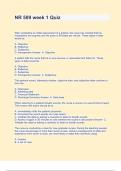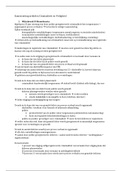Exam (elaborations)
NR 509 week 1 Quiz With Correct Answers 100% Guaranteed Pass
- Course
- Institution
NR 509 week 1 Quiz After completing an initial assessment of a patient, the nurse has charted that his respirations are eupneic and his pulse is 58 beats per minute. These types of data would be. A. Objective B. Reflective C. Subjective D. Introspective Answer- A. Objective A pati...
[Show more]












